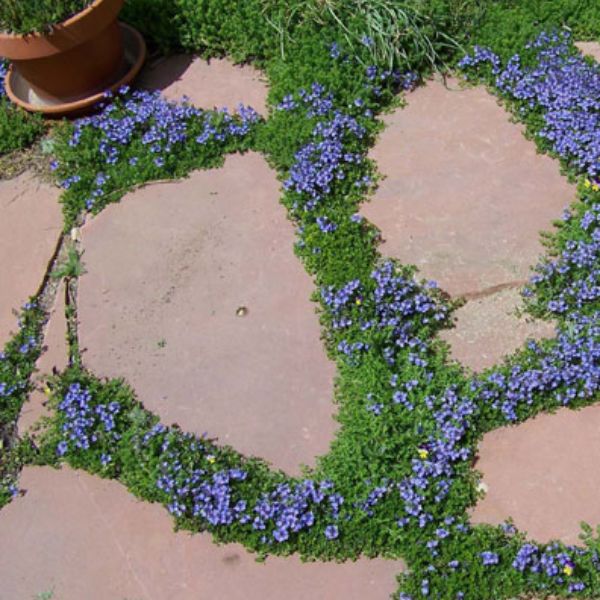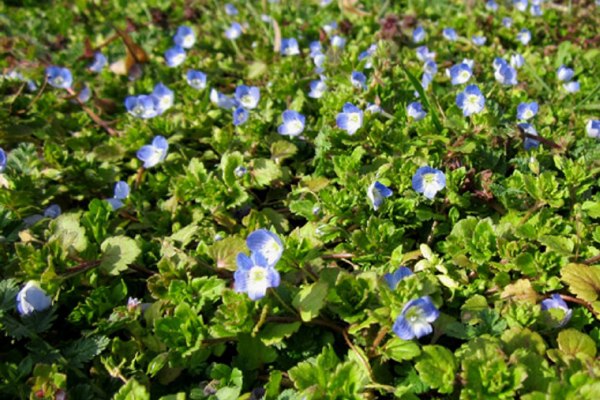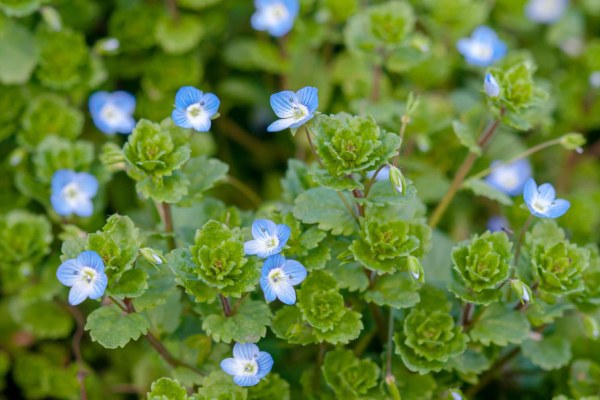Creeping speedwell, scientifically known as Veronica filiformis, is a low-growing perennial plant that is commonly grown for ground cover in lawns and gardens. The plant features small, scallop-shaped leaves that are quite hairy and have slightly jagged edges. It also produces small pale blue or almost white flowers on longish stalks that bloom from April to July. The flowers consist of four rounded petals that can also appear in shades of pink purple, and white. Similarly, creeping speedwell is a trailing perennial that grows up to 5 inches tall and can spread to about 30 inches wide. It can tolerate partial shade as well as moderate foot traffic, which makes it a popular choice for ground cover in various settings. In this guide, we will explore more about Creeping Speedwell, including how to grow it and the best ways to take care of it.
Plant Descriptions
Plant Type: Perennial, groundcover
Scientific Name: Veronica filiformis
Common Name: Creeping Speedwell, Slender Speedwell
Family: Plantaginaceae
Season: Spring, summer
Native Area: Europe, Asia
Toxicity: Non-toxic
Planting Guide to Creeping Speedwell
Creeping speedwell thrives best when planted during the cooler months of spring or fall. As it doesn’t do well in hot weather, it is best to start seeds indoors in late winter or early spring, before the last frost-free date. For outdoor cultivation, seeds can be sown directly in mid to late spring, once the risk of frost has passed. Creeping speedwell is commonly found growing wild in various environments such as lawns, fields, and meadows. When selecting a planting site, it is ideal to choose an area that receives bright, indirect sunlight and has well-draining soil. However, planting in excessive shade may lead to a reduction in flowering. Creeping speedwell blooms from spring to fall, and some types even flower more than once during this time. This plant is very hardy and can withstand mowing and foot traffic, making it a great choice for ground cover in both gardens and natural areas.

How to care Creeping Speedwell
Lighting
Creeping speedwell grows best in bright, indirect sunlight. It can also tolerate some partial shade, especially in the afternoon when the sun is hottest. In hot areas, too much direct sunlight can stress the plant and cause it to wilt. Similarly, if the plant is kept in full shade then it may not flower well and will have fewer blooms. So, it’s important to find the right amount of sunlight for creeping speedwell to grow healthy and bloom well.
Soil Preparations
Creeping can grow in all sorts of soil types, as long as it drains well and holds some moisture. It does best in loamy and sandy soils that are moist, but it can also handle some clay soil. Additionally, these plants prefer soil that is neutral in pH, but they can survive in soils that are slightly acidic or slightly alkaline.
Watering
Young speedwell plants require daily watering when they are newly planted to establish their roots. Once established, you can reduce the frequency of watering as they become more drought-tolerant. Similarly, if you water too much, it can cause the stems and roots to rot. So, it is recommended to water only when the top inch of soil is dry. You can also add a thick layer of compost or mulch that helps to retain moisture.
Temperature and Humidity
Creeping speedwells are so well adapted to various environmental conditions as long as it is planted in USDA hardiness zones 3 to 9. In warm climates, the plant will remain evergreen, but in areas with more seasonal temperature changes, it may lose its leaves during colder months.
Fertilizer
This plant doesn’t require much feeding. However, if you want to give the plant extra nutrients, you can add compost or a balanced fertilizer to the soil in early spring which boosts its growth.
Pruning
Pruning is not necessary for creeping speedwells. However, some gardeners may choose to prune for an aesthetic display and to maintain the plant’s health. The best time to prune is in late summer, especially if you live in areas with cold winters. Pruning at this time helps the plant grow stronger and more likely to survive the winter. If you have small patches of creeping speedwells, you may use garden snips to prune the plant. But if you have a large area where the plant is used as ground cover, a lawnmower is more efficient.
Common Issues with Creeping Speedwell
Creeping speedwell is a very hardy plant that usually does not have many problems, but sometimes issues may arise when the soil is either too wet or too dry which can cause the leaves to wilt, become soggy, or turn yellow.

Also read Low-Maintenance Lawn Grasses That Practically Take Care of Themselves!
Wilting Foliage: This often happens in hot climates where the soil dries out quickly. To help your creeping speed well, plant it in a spot that gets afternoon shade and increase how much and how often you water it.
Soggy, Wilting, and Yellowing Foliage: These signs indicate that the plant is getting too much water, which can lead to root rot. If you notice these symptoms, cut back on watering and only water when the top inch of soil is dry. If you suspect root rot, dig up the plant and remove any infected roots and leaves. Before replanting, improve the soil by adding well-draining materials like sand or compost to prevent future problems.
How to Propagate Creeping Speedwell
Creeping speedwell can be easily propagated through several methods including division, cuttings, or layering. Each method has specific steps which are mentioned below:
Division
To maintain a plant that has become thin or untidy, you can divide it in early spring using a garden shovel, hand shovel, snips, and gardening gloves. First, dig around the plant to lift it out of the ground carefully. Then, divide the plant into sections, making sure each section has healthy leaves and roots while discarding any bare or unhealthy parts. Finally, replant each healthy section in your desired location to promote better growth and improve the plant’s appearance.
Cuttings
To propagate a plant using stem cuttings, start by cutting a 6-inch stem just below a leaf node with snips or scissors. This technique ensures that the cutting has the best chance of developing roots. After cutting, remove the lower leaves from the stem to prevent them from rotting in the soil. Next, plant the cut end of the stem in moist soil. However, make sure the soil is consistently moist but not overly wet. Excessive moisture can lead the cutting to rot. After that, place the cutting in an area with bright, indirect light. Once the roots have formed and are well-established, you can move the cutting to its permanent location, whether that be a pot or a garden bed.
Layering
In this technique, a part of the plant stem called a node is buried in the soil to help it grow roots. After waiting a few weeks, you can check if roots have formed by gently pulling on the buried section. If you feel resistance, it means roots have developed. Once the roots are established, you can either leave the new plant in its original spot or carefully separate it and replant it in a different location.
Growing Creeping Speedwell from seeds
You can grow Creeping Speedwell from seeds either indoors or outdoors, depending on your preference. If you choose to start indoors, plant the seeds 8 to 10 weeks before the last frost. For outdoor planting, you can sow the seeds directly after the frost has passed. Since the seeds are very small and can be easily blown away, it is important to prepare a sheltered, weed-free area for them. Follow these detailed steps:
- Prepare the Pots: Fill small pots with a seed-starting mix and lightly moisten the soil to create the ideal environment for the seeds.
- Sow the Seeds: Sprinkle the tiny Creeping Speedwell seeds evenly over the damp soil surface and gently press them in. Don’t cover them with soil, as they need light to germinate.
- Provide Light: Place the pots in an area with bright, indirect light. If you are planting outside, keep an eye on the soil to ensure it doesn’t dry out.
- Maintain Moisture: Keep the soil consistently moist until the seeds germinate, which usually happens within 1 to 2 weeks.
- Transplanting outdoors: Once the frost has passed in your area, transplant your Creeping Speedwell seedlings outdoors, ensuring they have enough space to grow and spread.
Controlling Creeping Speedwell
Creeping speedwell can become problematic in certain environments due to its vigorous growth and ability to form dense mats. In many areas, it is considered an invasive weed due to its aggressive growth, which allows it to outcompete other plants for resources and invade unwanted spaces. Therefore, it is important to use proper management strategies to control its spread, especially in gardens or lawns.

- Regularly prune the plants to prevent them from taking over areas where you don’t want them.
- Hand pulling can be effective, especially when done carefully to remove the entire plant, including roots and runners.
- Use garden edging or barriers at least 4 inches into the soil to block its underground runners.
- Apply pre-emergent herbicides in early spring before speedwell seeds germinate to prevent them from further establishment.
- Tilling the soil in the fall or late winter can disrupt the germination of speedwell seeds.
- Use post-emergent broadleaf herbicides during late spring or early summer when the plants are actively growing.
Frequently Asked Questions
1. What is Creeping Speedwell?
Creeping speedwell, or Veronica filiformis, is a low-growing perennial plant that is commonly grown for ground cover in lawns and gardens. The plant features small, scallop-shaped leaves that are quite hairy and have slightly jagged edges. It also produces small pale blue or almost white flowers on longish stalks that bloom from April to July.
2. What is the plant type of the Creeping Speedwell?
Creeping speedwell is a perennial groundcover plant from the family Plantaginaceae. It originates from Europe and Asia.
3. How tall and wide does Creeping Speedwell grow?
This low-growing, mat-forming perennial grows to 5 feet tall and spreads to as much as 30 feet wide.
4. When does Creeping Speedwell bloom?
It blooms from April to July with pale blue, white, pink, or purple flowers.
5. Where should I plant Creeping Speedwell?
It prefers bright, indirect sunlight but will tolerate partial shade. It does well in a well-drained type of soil and can support moderate foot traffic, hence creeping speedwell is ideal for ground cover over the lawn or garden.
Also read What are Meadow Grasses and How can identify them?
